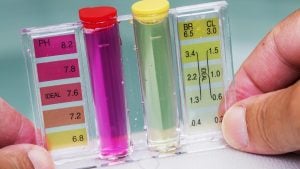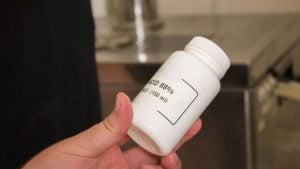PH of Beer: All You Need To Know About Controlling the PH in Beer
 Knowledge about the pH of beer is fundamental to beer enthusiasts, especially homebrewers who are getting into making beer. As long as you achieve the proper pH, your beer will taste exactly the way it’s meant to be.
Knowledge about the pH of beer is fundamental to beer enthusiasts, especially homebrewers who are getting into making beer. As long as you achieve the proper pH, your beer will taste exactly the way it’s meant to be.
Beer pH is also an essential factor when maintaining beer quality during storage. With all of these in mind, we will explore everything you need to know about pH and how to control it in this comprehensive guide.
What Is the pH of Beer?
Beer pH stands for the power of hydrogen or the potential of hydrogen. The chemical variable indicates the level of acidity or alkalinity in beer. The value shows the concentration of hydrogen ions, so if the concentration of hydrogen ions increases, the beer is more acidic. On the other hand, if the number decreases, that means it is caustic or has more alkaline.
The pH levels you achieve will affect your beer’s color, extract potential, hot-break formation, hop bitterness, hop oil extraction and beer foam stability. Also, since low pH leads to bacterial growth, it’s essential to control this level when storing your beer.
How to Measure pH
The pH scale goes from 0 to 14, going from very acidic to high alkalinity. Levels 0 to 7 is acidic, while 8 to 14 is alkaline, and any liquid set on 7 is neutral. Most food and drinks we consume are on level 7, but beer pH levels can go as low as 3.
If you want to measure the pH level of beer, you need to use a pH tester if you are a homebrewer. Using litmus paper is only ideal for learning purposes and will be imprecise for what you are about to do. It would be best to look out for testers that are accurate to ±0.01 pH.
After purchasing the tester, the next thing to do is clean and soak the bulb sensor then use a 2-point or 3-point calibration. You can test if it’s working properly by placing it in a solution that you already know the pH of.
Once you’re sure it’s working, you can use it on your wort and take notes of the pH level from the mashing to the fermentation. This will also come in handy for the next time you’re brewing that kind of beer.
PH Levels of Different Beers
While the average pH of beer is usually set at around 4, the value depends on the type of beer you’re making. The pH level for ale will be different from that of wheat beer, and regardless, it’s usually in the acidic range. Check the beer recipe you’re making for information on the pH level to make sure you’re doing it right.
Here are the pH levels for different types of beer:
- Ale: 4.0 – 4.5
- Lager: 4.2 – 4.6
- Porter: 3.5 – 5.5
- Stout: 4.0 – 4.3
- Blonde Ale: 5.1 – 5.4
- Brown Ale: 5.2 – 5.6
- Pale Ale: 5.3 – 5.4
- Indian Pale Ale: 5.3 – 5.5
- Wheat Beer: 4.1 – 4.5
- Pilsner: 4.1 – 4.9
- Sour beer: Averaging 3.0
The pH level starts from the water content in the beer, including the minerals and ions found in the water. Thus, adding acid or ions can help adjust the wort’s acidity. If you want to know the pH level, you should get it at the end of your brewing process, check the beer acidity chart on your recipe or use the above ranges.
The Correct Mash pH
 While it’s essential to know the pH of finished beer, you need to start from the mash pH. The pH of an infusion mash for all types of beer should be between 5.2 and 5.6, and it’s much better if it’s in the lower half. This range offers a balance between the brewing process and optimum pH.
While it’s essential to know the pH of finished beer, you need to start from the mash pH. The pH of an infusion mash for all types of beer should be between 5.2 and 5.6, and it’s much better if it’s in the lower half. This range offers a balance between the brewing process and optimum pH.
Getting the correct pH from the mash will affect the tannin extraction, extract yield, saccharification time, fermentability and lauterability of your beer. You get the best extract yield when the mash pH is between 5.2 and 5.4, and the wort will quickly convert to beer with a pH of 5.3 to 5.6. The 5.3 to 5.4 range will give you a very fermentable wort.
Having a pH level that is too high comes with adverse consequences for your mash, and in the worst case, you have a less fermentable wort. This affects the starch and protein hydrolysis and will extract too many polyphenols in the beer. This causes instability and astringency once the beer is ready.
The extraction of polyphenols usually happens during sparging; if your pH is exceeding 5.6 and climbing to 5.8 and 6.0, you should stop collecting wort. Different factors affect whether you achieve the correct pH level, including the mash thickness, temperature, and the type of mash used. If you missed the mark when making your beer, you can fix things up by getting the proper pH.
How to Adjust Mash pH
Even if you know the correct pH for your beer, you might not achieve the optimum level during your homebrewing. Thus, you need to know how to get the suitable mash pH.
Beginners in homebrewing will mostly complain that their mash pH is too high regardless of what they do, and this usually boils down to the ions in the water. The ions or carbonates in the water or the type of water being used can make the pH level too high or too low.
– Lower the pH
If the pH of your mash is too high, there are different things you can do to lower it.
- Add calcium ions from calcium sulfate or calcium chloride. By adding 2 teaspoons in a 5-gallon batch, you can reduce the pH level.
- Add phosphoric, lactic or other organic acids to the mash pH to lower it.
- Reduce the carbonates level if this is the cause. You can reduce it by boiling the water and letting it precipitate. You can also treat the water or use distilled water.
– Increase the pH
If you’re using soft water for your beer, especially dark brews, the mash pH might be too low instead.
In cases like this, you should:
- Add chalk, which is calcium carbonate.
- Add baking soda, which is sodium bicarbonate.
The Boil pH
Any homebrewer will know that they leave it to boil for a certain period after mashing the wort. The beer acidity level is just as important when boiling as when you were mashing the grain bill. When your wort is boiling, the calcium phosphate will precipitate, which causes the pH to decrease the longer it boils.
Thus, after boiling, the pH level of the beer is different from what it was during the mash. It should drop to between 5.0 and 5.2. In most cases, getting the correct mash pH will result in the proper boil pH without adding anything.
If your boil pH lands in the correct range, you get more character from your hops in terms of the aroma, taste and appearance. You get a coarse bitterness and other downsides without the suitable pH as you taste your beer.
– Effects
The boil pH affects different parts of your beer, starting with the isomerization of alpha acids to iso-alpha acids, and this works best with a higher pH. The hot break, which is proteins and polyphenols, also coagulates during the boiling stage, and having the correct pH will give you a fluffy and smooth beer.
Another way the boil pH affects the beer is its color, which usually increases during the boil because of the reactions between sugars and amino acids. This isn’t possible when the pH level is low, so if you want your beer to have a lighter color, you need to lower the pH. On the other hand, deeper and darker colors come with a higher pH.
– Adjusting Boil pH
There’s not much you can do to lower the boil pH, but you can add between a quarter to half of the calcium chloride or gypsum to five gallons of wort. Adding acid will also do the trick.
PH in Fermentation
Beers usually finish at a much lower pH than the mash and boil pH because of the fermentation. Fermentation reduces the pH because the yeast cells consume ammonium ions and give out organic acid. The type of yeast strain you choose will determine the beer finish.
The beer will age and mature faster if you get the right pH, mostly less than 4.4 for most beers. It also gives you improved biological stability, beer clarity and a refined taste that will impress you.
The color of the beer also becomes lighter during fermentation because some molecules lose their color as the pH reduces. This gives you a lighter beer once you pour it out of the keg to drink.
Controlling pH During Fermentation
You shouldn’t add more acid to the final beer if the pH level is too low. What you need to do instead is put the beer through intense fermentation. As the attenuation of the pH level reduces, the beer will have a low pH value.
History
Although you might be familiar with the pH of beer, you might not know that the concept originated from Soren Sorensen, a Danish biochemist who worked at Carlsberg labs in 1909. He came up with the pH when researching amino acids, proteins and enzymes, as he wanted to make a precise tool that showed the exact condition of the liquid.
Due to this, Sorensen was nominated for the Nobel Prize in chemistry, medicine and physiology, although he didn’t win anything. He also became president of the Royal Danish Academy of Sciences because of his work.
After that, Carlsberg J.P. Jacobsen was interested in the pH scale because it would help check if the beer was fermenting as it’s supposed to. This is done by checking the alkalinity or acidity of beer. Jacobsen thus introduced the pH scale into brewing beer, and it is still used today.
Conclusion and Summary
 All homebrewers must understand how the pH of beer works because while it might appear to be unimportant, getting it right or wrong can either make or break your entire brewing process.
All homebrewers must understand how the pH of beer works because while it might appear to be unimportant, getting it right or wrong can either make or break your entire brewing process.
- Beer pH is used to check the level of acidity or alkalinity in a solution such as beer, in this instance.
- It was introduced in 1909 by Soren Sorenson and popularized for beer use by Carlsberg J.P. Jacobsen.
- The pH scale is between 0 and 14, with 0 to 7 being acidic.
- You can measure your beer’s pH with a well-calibrated tester.
- The average pH level for beer is 4, but it usually differs based on the type of beer.
- The pH level usually starts at around 5.6 on the mash but reduces throughout the boiling and fermentation process to give the finished result.
- Depending on whether it’s the mash or boil, you can adjust the pH level by adding ions, acids, salts and other components.
So the next time you open your homebrewing kitchen, remember to have your pH tester at hand for the best results.






